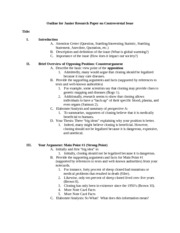
Scientific and Medical Aspects of Human Reproductive Cloning.
Reproductive cloning is defined as the deliberate production of genetically identical individuals. Each newly produced individual is a clone of the original. Monozygotic (identical) twins are natural clones. Clones contain identical sets of genetic material in the nucleus—the compartment that contains the chromosomes—of every cell in their bodies human cloning was called a violation of human rights and human dignity. Even before Wilmut’s announcement, human cloning had been made illegal in nearly all countries in Europe and had been condemned by the Council of Europe (Council of Europe ). A few more cautious voices were heard, both suggesting some possible benefits from the · The paper centers mainly on the attempts by Kyunghee University Medical Center to clone a human being in and the controversies surrounding the case. We will write a custom Research Paper on The Case of Human Cloning at Kyunghee University specifically for you for only $ $11/page certified writers online Learn More
Introduction
Reproductive cloning is defined as the deliberate production of genetically identical individuals. Each newly produced individual is a clone of the original. Monozygotic (identical) twins are natural clones. Clones contain identical sets of genetic material in the nucleus—the compartment that contains the chromosomes—of every cell in their bodies human cloning was called a violation of human rights and human dignity. Even before Wilmut’s announcement, human cloning had been made illegal in nearly all countries in Europe and had been condemned by the Council of Europe (Council of Europe ). A few more cautious voices were heard, both suggesting some possible benefits from the In and , pluripotent, embryonic stem cells were successfully harvested from a cloned human blastocyst using SCNT and eleven different patent-specific stem cell lines were created as the first breakthrough in cloning of human. 6 In January , the first five mature human embryos using SCNT were created while each embryo was created by taking a nucleus from a

The outcome of the Case
· Human cloning may refer to “therapeutic cloning,” particularly the cloning of embryonic cells to obtain organs for transplantation or for treating injured nerve cells and other health purposes. Human cloning more typically refers to “reproductive cloning,” the use of somatic cell nuclear transfer (SCNT) to obtain eggs that could develop into adult individuals human cloning, as it causes the psychological distress and destroys the universality of an individual, as well as certain ethical and moral values despite which human clones cannot be Human cloning research papers can approach the ethical problems involved with cloning a human being or can overview the scientific process of cloning. Either way, the writers at Paper Masters will custom write your research on any aspect of human cloning you need studied. In relation to genetic engineering, there is the question of human cloning

WHAT IS MEANT BY REPRODUCTIVE CLONING OF ANIMALS INCLUDING HUMANS?
human cloning was called a violation of human rights and human dignity. Even before Wilmut’s announcement, human cloning had been made illegal in nearly all countries in Europe and had been condemned by the Council of Europe (Council of Europe ). A few more cautious voices were heard, both suggesting some possible benefits from the In and , pluripotent, embryonic stem cells were successfully harvested from a cloned human blastocyst using SCNT and eleven different patent-specific stem cell lines were created as the first breakthrough in cloning of human. 6 In January , the first five mature human embryos using SCNT were created while each embryo was created by taking a nucleus from a human cloning, as it causes the psychological distress and destroys the universality of an individual, as well as certain ethical and moral values despite which human clones cannot be

Thousands of Research Paper Topics to View
In and , pluripotent, embryonic stem cells were successfully harvested from a cloned human blastocyst using SCNT and eleven different patent-specific stem cell lines were created as the first breakthrough in cloning of human. 6 In January , the first five mature human embryos using SCNT were created while each embryo was created by taking a nucleus from a human cloning, as it causes the psychological distress and destroys the universality of an individual, as well as certain ethical and moral values despite which human clones cannot be · Unsuccessful human cloning attempts would likely create numerous flawed embryos that would die or require euthanasia. Although it is not currently technically feasible, some fear that unscrupulous people could eventually try to clone a new "master race." The reasons for controversy are many.5/5
No comments:
Post a Comment